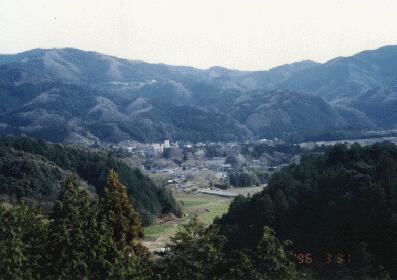Some Notes on the Battle of Nagashino, 1575
One of the interesting things about the film Kagemusha is that is based
on a real battle, the Battle of Nagashino in 1575. The film centers around the
Takeda Clan one of the most feared enemies in an era where great warlords were
contending with one another to rule the entire country. The film also features
two important historical actors in this era, Oda Nobunaga (1534-1582) and Tokugawa
Ieyasu (1546-1616). Oda was the first of the three great unifiers. He was succeded
by Toyotomi Hideyoshi (1536-1598) who rose from peasant origins to the highest
position (regent) among the warlords. But his successor was only a child when
he died so the coalition supporting the "heir" was ultimately defeated
at the Battle of Sekigahara (1600) by Tokugawa Ieyasu, the only one of the three
to succeed in being named Shigun.
Oda was assassinated by one of his own generals before he fully consolidated
power, but he was the first Daimyo (or Warlord) to claim that he was fighting
to unify the entire country under one military ruler. He chasd the last Ashikaga
Shogun out of Kyoto and was on his way to consolidating his power when he was
betrayed. Oda comes down in history as utterly pragmatic, ruthless, tough and
without remorse. he slaughtered thousands of monks and civilians at the Buddhist
stronghold on Mt. Hiei. In the film we see Oda in a variety of settings: as
a top general planning war strategies, as wellas leaping up and performing a
passage from a Noh play. But we also see him dressing in European clothes and
even European armor as he marches off to battle with the foreign (Portuguese)
priests blessing him as he departs. So he comes off as an eccentric, but one
who is bold and daring; one who is willing to embrace foreign technologies,
and to take chances. He even drinks the strange, red, foreign sake--wine--of
which he gives Iyeasu a taste in the film. The latter is unprepared for the
sharp, acrid taste.
The Battle of nagashino was a turning point. It not only put oda in a position
to oust the Shogun and take Kyoto, but it also saw the end of one kind of warfare
and the advent of another featuring the use of mass armies armed with muskets.
Below is part of a painting of the battle for a screen:

Battles at this time in Japan were starting to transform from contests between
two samurai armies, primarily mounted, elite samurai, to contests between mass
armies including armed peasants known as "Ashigaru" or foot
soldiers, led by samurai. It was not uncommon to have armies of more than 100,000
on the battlefield at one time.
At the Battle of Nagashino, Oda Nobunaga defeated Takeda Katsuyori, son of
the famous Takeda Shigen. In this battle Oda had 38,000 men with 10,000 of them
being riflemen. 3000 of these riflemen were placed across a stream and behind
breastworks using 1000 rounds fired in volley after volley in order to break
the famous Takeda Cavalry. The same tactics were seen centuries later in Europe.
As distinguished historian George Sansom describes the battle:
Takeda opened the attack with the old-style order of battle: four waves
of mounted warriors charged one after the other against the defences erected
by Nobunaga . They were all destroyed before they reached his front line.
Nobunaga had set up wooden palisades in a zig-zag pattern, of a height which
horses could not overleap. Takeda's cavaliers were brought up short against
this obstacle and were shot down from behind it by some 3,000 foot soldiers
armed with muskets. Every successive charge of the Takeda warriors was repulsed
with heavy losses, while the defenders suffered hardly a scratch.
Sir George Sansom, A History of Japan 1334-1615, p. 287.
Below, see some details of the battle from the screen:



For these images and more detailed information see Matthew Stravos'
pages at:
As Prince notes, one of the things that fascinated Kurosawa was
that Takeda Shingen's philosophy of war had always been to stay put, in his
domain, rock solid, like a mountain, hence his nickname, "Yama."'
But once the enemy entered his territory and it was time to attack, then his
philosophy was to swoop down as rapidly as the wind, as silently as the
forest, and attack as mercilessly as fire in order to destroy
the invader. Shingen's battle flags bore the 4 Chinese characters for Wind,
Forest, Fire and Mountain. In the film Kagemusha,
the son Katsuyori, in his zeal to step out of his father's shadow, is depicted
violating Shingen's fundamental premise and movings 15,000 of his best troops
outside of his domain in order to engage the enemy in the fateful battle in
the valley at Nagashino, which, by the way, looks like this today:

Recall the scene where one of the elder Generals stops Katsuyori
as the ride along the coast and asks him what the multi-colored, "horizontal
rainbow" sky signifies. He tries to persuade Katsuyori that this was his
late father Shingen's way of telling him to turn around and return to their
own domain. Around 10,00 of these elite troops would perish that day. For a
detailed account of the battle, click here.





